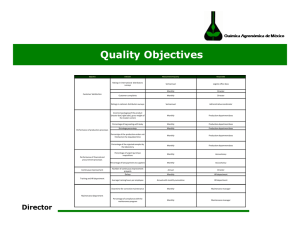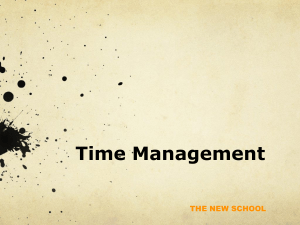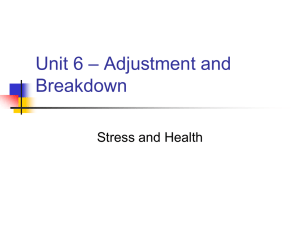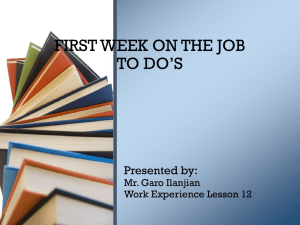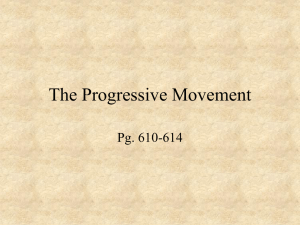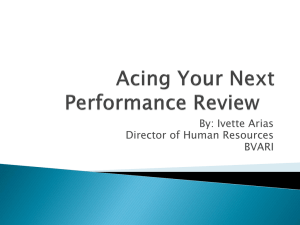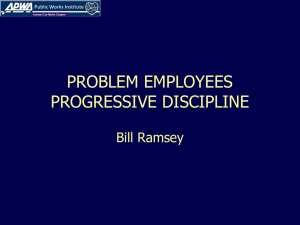Family Stress Management Presentation
advertisement
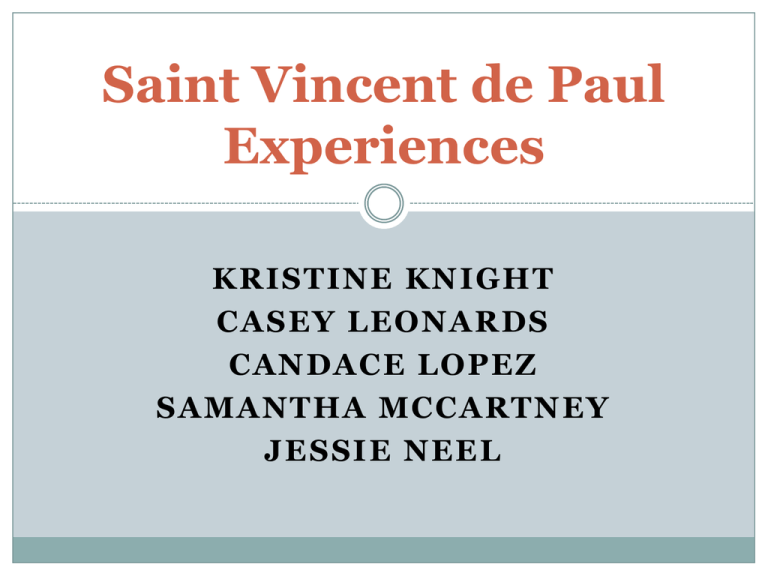
Saint Vincent de Paul Experiences KRISTINE KNIGHT CASEY LEONARDS CANDACE LOPEZ SAMANTHA MCCARTNEY JESSIE NEEL Overview Values/Beliefs Kristine Knight Denial Candace Lopez Demoralization Kristine Knight Problem Focused Stress Casey Leonards Stress Pile-Up Casey Leonards Palliative Behaviors Candace Lopez Coping Samantha McCartney Acute vs. Chronic Behaviors Samantha McCartney Resilience Jessie Neel Emotion Focused Coping Jessie Neel Values/Beliefs A value is something that is a desired quality of ongoing or continual action. A belief can change and be molded with time. Fatalism (Boss, 2002) is the acceptance of situations and events not because of law or predetermination by a higher power, but primarily because of cultural and environmental conditioning that reinforces a sense of powerlessness. Demoralization Demoralization is the loss of morale and family unity (Boss, 2002). The individual’s or family’s internal context is composed of elements the family can change and control (Boss, 2002, p.44). Stress and Family Stress Hans Selye defined stress as “the common denominator of all adaptive reactions in the body” (Boss, 2002, p. 16). “A state manifested by a specific syndrome, consisting of all the nonspecifically induced changes within a biologic system” (Boss, 2002, p.16) Boss defines family stress as pressure or tension in the family system- a disturbance in the steady state of the family- a change in the family’s equilibrium (Boss, 2002, p. 16). Stress is normal in couples and families. Stress is inevitable because with any change comes disturbance- the guest at SVDP had a very stressful time because they moved from a home to a shelter. Stress Pile-Up Pile-up of stress can help explain why one event can be the straw the breaks the family’s back (Walker, 1985). One event leads to another, and one may come up glued because the stress pile-up is so unbearable. Residents would fight over food or have a argument because someone took their apple. This could have been because stress pile-up. This was the straw that broke the camels back. Palliative Behaviors “Lazarus defines individual coping as direct action behaviors (fight or flight) that deal with the stressor and as palliative behaviors (actions or thoughts which make the person feel more calm)” ( Boss, 2002, p. 73). “He holds that an individual’s coping behavior is organized not by emotions but by the cognitive process that leads to the emotional response” (Boss, 2002, p. 73). Palliative Behaviors are common among those in unfortunate situations because it is their way to cope with the misfortunes they are dealing with in their lives. During my visits to St. Vincent de Paul women’s shelter I interacted with a number of the women that live there. A few of them displayed palliative behaviors in the way they would get competitive during BINGO. As if for that brief time all the worries they had were to win BINGO and not that they had nowhere to go and no one to help care for them. Denial Boss defines denial as “the refusal to believe what one sees or hears. It is the refusal to believe or accept a physical reality” (Boss, 2002, p. 123). • In the case of the ladies at St. Vincent de Paul, I witnessed at least one case of denial. • One of the ladies had a son who was also homeless and she would meet up with him about once a week. Every time she would see him, he would promise her that he was going to get them out of their current situation. Every time I would ask her how those plans were going, she would tell me that it was going great but that her son just was not ready for her yet. She would continue to tell me that he was going to get it all together and come get here, but I think deep down inside she knew he would never get his act together. I believe that her staying in denial kept her hopes alive. Problem Focused Coping Used to master or manage a stressor (Boss, 2002) Problem focused coping targets the cause of stress Aim to remove or reduce the stressor Take control of situation Seek out information St. Vincent de Paul Male resident asked to talk to employee Showed his ticket Acute vs. Chronic Behaviors Chronic Stressors Situation (as oppose to an event) of disturbed equilibrium that persists over a long period of time (Boss, 2002) A long-term situation rather than a one-time event (Boss, 2002) Acute Stressors Events that happen suddenly and last only a short time Duration is usually predictable St. Vincent de Paul Most people experience Chronic Stressors like living in dangerous conditions and in constant danger Many also experience Acute Stressors Man with broken arm for 3 weeks Resilience The ability to recover from misfortunes and challenges (Boss, 2002) Must study both individuals and the family for a better understanding of resilience SVDP guest portrays resilience Despite his past misfortunes, he found a job Emotion Focused Coping Used when there is little that someone can do to change the stressor (Boss, 2002) Actions and thoughts to make someone feel better Typically used by older people SVDP guests are happy and thankful, even though experiencing high stress Man is thankful to wake up Woman happy and grateful still Conclusion Working at the dining hall exposed Kristine to a variety of people with different experiences. People cope with their homelessness in a number of ways. Two ways in which she noticed were those of acceptance and those of shame. Both held fatalistic views but she found that those who were demoralized and had not changed their values had a greater chance for escaping homelessness because they still had the desire to change. Demoralization is a loss of morale Values are desired qualities that are difficult to change while beliefs are changeable. Conclusion Stress is “A state manifested by a specific syndrome, consisting of all the nonspecifically induced changes within a biologic system” (Boss, 2002, p.16) Boss defines family stress as pressure or tension in the family system- a disturbance in the steady state of the family- a change in the family’s equilibrium Pile-up of stress can help explain why one event can be the straw the breaks the family’s back (Walker, 1985). Conclusion As stated earlier in Boss (2002), palliative behaviors are actions or thoughts which make the person feel more calm (p. 73). Denial is refusing to see or hear what is really going on in one’s life. Conclusion Boss, 2002, explains that Acute stressors are events whereas Chronic stressors are situations Acute Stressors happen suddenly and last a short time Chronic Stressors long term situation Problem Focused Coping is used to master or manage a stressor. It aims to remove or reduce a stressor Problem Focused Coping takes control of the situation Seek out information to better understand the stressor/event Conclusion As Boss (2002) explains resilience is the ability to recover from a misfortune or challenge. To better understand resilience, the individual and the family must be studied. Emotion focused coping is a coping strategy that people use when there is little they can do to change the stressor. It includes actions and thoughts to make them feel better. References Boss, P. (2002). Family stress management: A contextual approach (2nd ed). Thousand Oaks, CA: Sage. Walker, A., J. (1985). Reconceptualizing family stress. Journal of Marriage and the Family, 827-837.
